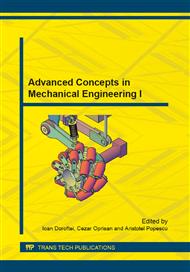[1]
P.C. Yang, C.H. Norris, Y. Stavsky, Elastic Wave Propagation in Heterogeneous Plates, Int. Jour. Solids. Struct., 2 (1965), 664-684.
Google Scholar
[2]
J.M. Whitney, N.Y. Pagano, Shear Deformation in Heterogeneous Anisotropic Plates, Jour. Appl. Mech., 37 (1970), 1031-1036.
DOI: 10.1115/1.3408654
Google Scholar
[3]
J.N. Reddy, A Review of Refined Theories of Laminated Composites Plates, Shock and Vibration, 22 (1990), 3-17.
Google Scholar
[4]
A. Noiser, R.K. Kapania, J.N. Reddy, Free vibration analysis of laminated plates using a Lay-Wise Theory, American Institute of Aeronautic and Astronautics Journal, 31 (1993), 2335-2346.
DOI: 10.2514/3.11933
Google Scholar
[5]
V.N. Paimushin, I.M. Zakirov, et. al., Average Elastic and Strength Characteristics of a Honeycomb Core and a Theoretical-Experimental Method of their Determination, Mechanics of Composite Materials, 48 (2012), 511-524.
DOI: 10.1007/s11029-012-9296-0
Google Scholar
[6]
N.I. Akishev, I.I. Zakirov, et. al., Theoretical-Experimental Method for Determining the Averaged Elastic and Strength Characteristics of a Honeycomb Core of Sandwich Designs, Mechanics of Composite Materials, 47 (2011), 377-386.
DOI: 10.1007/s11029-011-9216-8
Google Scholar
[7]
M.S. Konsta-Gdoutos, E.E. Gdoutos, The Effect of Load and Geometry of the Failure Modes of Sandwich Beams, Applied Composite Materials, 12 (2005), 165-176.
DOI: 10.1007/s10443-005-1120-8
Google Scholar
[8]
V.E. Kryutchenko, Elastic Properties of Honeycomb Sandwich Plates with Non-traditional Cell Forms, Mechanics of Composite Materials, 33 (1997), 132-135.
DOI: 10.1007/bf02269599
Google Scholar
[9]
D.J. Edwins, Modal Testing. Theory and Practice, Bruel&Kjaer (1987).
Google Scholar
[10]
M.M. Stanescu, D. Bolcu, I. Manea, et. Al., Experimental Researches Concerning the Properties of Composite Materials with Random Distribution of Reinforcement, Materiale Plastice, 46: 1 (2009), 73-78.
Google Scholar
[11]
I. Manea, D. Bolcu, C. Miritoiu, Software for mechanical systems modal identification, Annals of the University of Craiova. Mechanical Series, 1 (2007), 191-199.
Google Scholar
[12]
C. Miritoiu, D. Ilincioiu, et. al., A Comparison Between the Modal Parameters Obtained by two Different Accelerometers, The 5TH International Conference on Manufacturing Science and Education – MSE 2011, 1 (2011), 39-43.
Google Scholar


